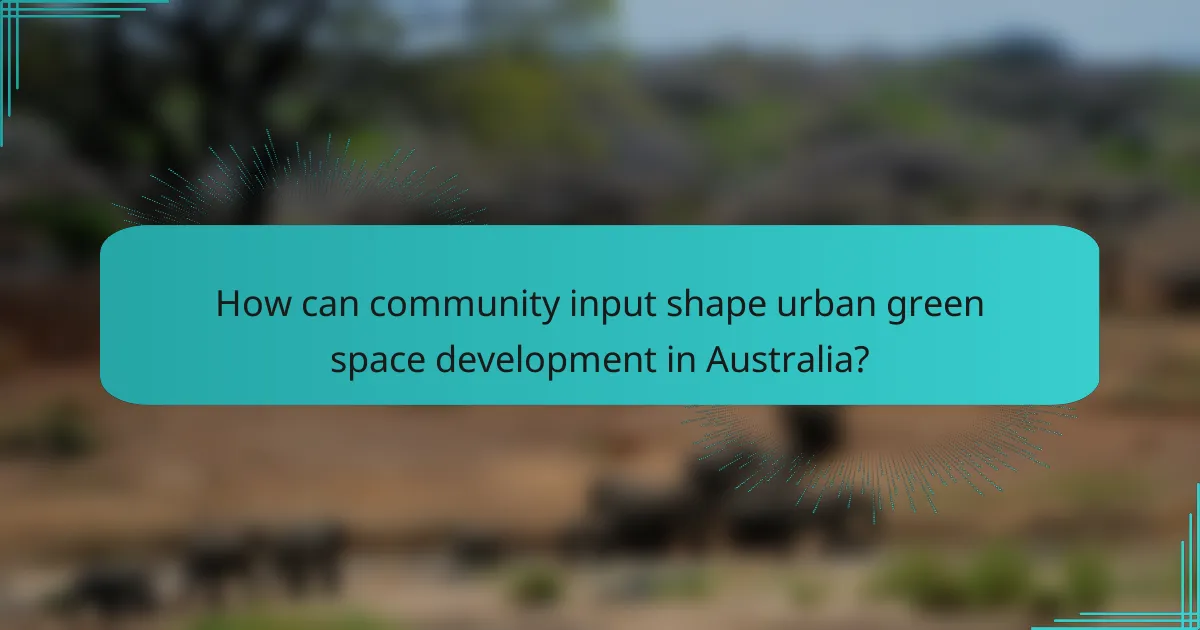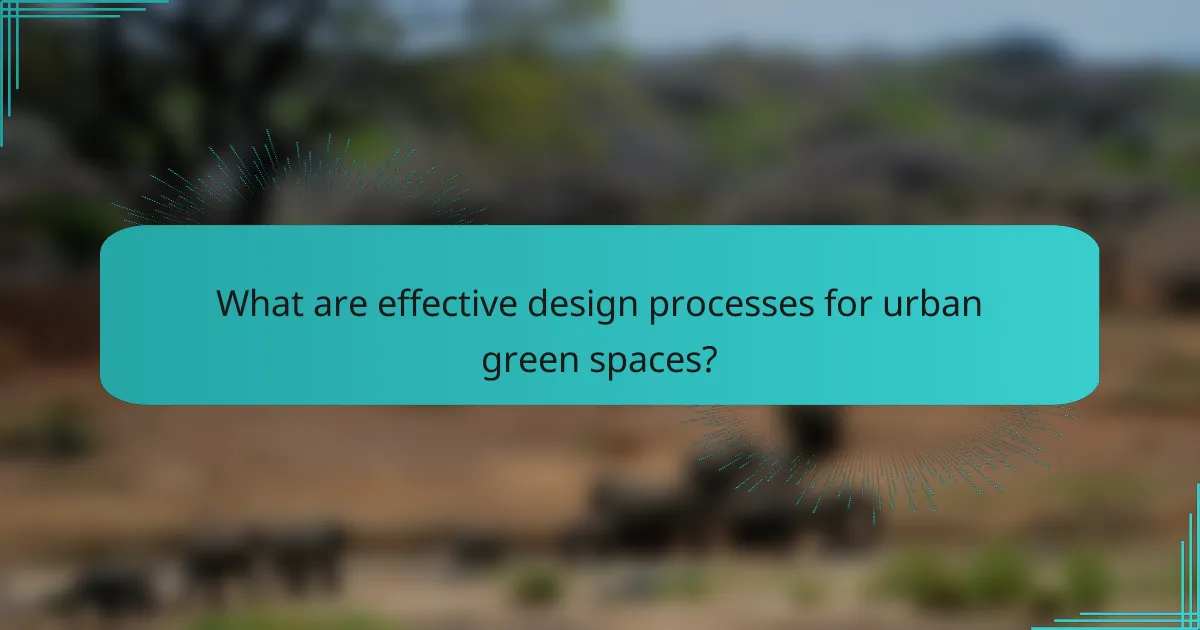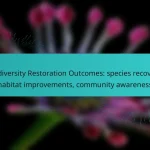Urban green space development is a collaborative process that relies heavily on community input to ensure these areas reflect the needs and desires of local residents. By integrating effective design processes and maintenance planning, stakeholders can create sustainable and accessible green spaces that enhance both community well-being and the environment.

How can community input shape urban green space development in Australia?
Community input is crucial in shaping urban green space development in Australia, as it ensures that these areas meet the needs and preferences of local residents. Engaging the community fosters a sense of ownership and can lead to more sustainable and well-utilized green spaces.
Public consultations
Public consultations are structured meetings where community members can express their views on proposed urban green space projects. These gatherings allow for direct dialogue between planners and residents, ensuring that diverse perspectives are considered. Effective public consultations can enhance transparency and build trust within the community.
To maximize participation, consider holding consultations at various times and locations, accommodating different schedules and demographics. Providing refreshments or incentives can also encourage attendance.
Surveys and feedback forms
Surveys and feedback forms are valuable tools for collecting community opinions on urban green space development. These instruments can be distributed online or in-person, allowing residents to share their preferences anonymously. This method can yield quantitative data that helps planners identify trends and priorities.
When designing surveys, keep questions clear and concise. Offering a mix of multiple-choice and open-ended questions can provide both structured data and qualitative insights.
Community workshops
Community workshops facilitate collaborative design processes, allowing residents to actively participate in shaping their green spaces. These interactive sessions can include brainstorming activities, design charrettes, and hands-on planning exercises. Workshops not only gather input but also educate participants about the design process and the benefits of green spaces.
To ensure inclusivity, provide materials in multiple languages and consider the accessibility of the venue. Engaging local artists or facilitators can also enhance creativity and participation.
Partnerships with local organizations
Forming partnerships with local organizations can strengthen community input in urban green space development. Collaborating with schools, environmental groups, and neighborhood associations can broaden outreach and foster a sense of collective responsibility. These organizations often have established trust within the community, which can enhance participation.
Consider leveraging these partnerships for co-hosting events, sharing resources, or co-developing projects. This collaborative approach can lead to more innovative and relevant green space solutions that reflect community values and needs.

What are effective design processes for urban green spaces?
Effective design processes for urban green spaces involve collaboration among stakeholders, the use of advanced design tools, and a focus on local ecology and accessibility. These elements ensure that the spaces meet community needs while enhancing the environment.
Collaborative design sessions
Collaborative design sessions bring together community members, urban planners, and landscape architects to gather diverse perspectives. These sessions can take the form of workshops, focus groups, or public meetings, allowing participants to voice their ideas and concerns about the green space.
Utilizing techniques like brainstorming and sketching can help visualize concepts. It’s essential to document feedback and prioritize suggestions to create a design that reflects the community’s desires.
Use of design software like SketchUp
Design software such as SketchUp allows for the creation of detailed 3D models of proposed urban green spaces. This technology helps stakeholders visualize the design and make informed decisions based on realistic representations.
Using such software can streamline the design process by enabling quick adjustments based on feedback. Additionally, it can facilitate presentations to the community, enhancing engagement and understanding of the project.
Incorporating local flora and fauna
Incorporating local flora and fauna into urban green spaces promotes biodiversity and creates a habitat for native wildlife. Selecting plants that thrive in the local climate reduces maintenance costs and increases the resilience of the green space.
Consideration of local ecosystems can also enhance community pride and education. Engaging local horticulturists or ecologists can provide valuable insights into suitable species and planting strategies.
Accessibility considerations
Accessibility is crucial in the design of urban green spaces to ensure that all community members can enjoy them. This includes planning for wheelchair access, pathways that accommodate strollers, and seating areas that are easy to reach.
Incorporating features like tactile maps and sensory gardens can enhance the experience for individuals with disabilities. Regular assessments of accessibility can help identify barriers and ensure compliance with local regulations, such as the Americans with Disabilities Act (ADA) in the United States.

What maintenance planning strategies ensure sustainability?
Effective maintenance planning strategies are crucial for ensuring the sustainability of urban green spaces. These strategies focus on regular upkeep, community involvement, and the use of appropriate plant species to create resilient environments.
Regular maintenance schedules
Establishing regular maintenance schedules is vital for the longevity of urban green spaces. These schedules should include tasks such as mowing, pruning, weeding, and irrigation, tailored to the specific needs of the plants and the local climate.
For instance, a bi-weekly mowing schedule during the growing season can help maintain aesthetics and health. It’s beneficial to adjust these schedules seasonally, ensuring that maintenance aligns with the growth cycles of the plants.
Community volunteer programs
Community volunteer programs can significantly enhance the maintenance of urban green spaces. Engaging local residents not only fosters a sense of ownership but also provides valuable labor for upkeep tasks like planting, weeding, and litter removal.
Organizing regular volunteer days can attract participation and build community spirit. Offering incentives, such as refreshments or recognition events, can further encourage involvement and commitment to the green space.
Use of native plant species
Incorporating native plant species into urban green spaces is a sustainable maintenance strategy. Native plants are adapted to the local climate and soil conditions, requiring less water and fewer chemical inputs compared to non-native species.
Additionally, they support local wildlife and biodiversity, contributing to a healthier ecosystem. Selecting a mix of native plants can enhance resilience against pests and diseases, reducing the need for intensive maintenance.
Budget allocation for ongoing care
Proper budget allocation for ongoing care is essential for the sustainability of urban green spaces. Cities should allocate funds specifically for maintenance activities, including labor, materials, and equipment.
A typical maintenance budget might range from 5% to 15% of the initial development cost, depending on the size and complexity of the green space. Regular reviews of the budget can help adjust funding based on changing needs and priorities, ensuring that maintenance remains a priority over time.

What criteria should be considered in urban green space design?
Key criteria for urban green space design include environmental sustainability, community needs, and effective space utilization. These factors ensure that green areas are beneficial, accessible, and well-maintained, fostering a positive impact on urban life.
Environmental impact assessments
Environmental impact assessments (EIAs) evaluate the potential effects of proposed green spaces on local ecosystems. This process involves analyzing factors such as biodiversity, water management, and soil health to ensure that the development supports environmental sustainability.
When conducting an EIA, consider using tools like GIS mapping to identify sensitive areas and existing wildlife habitats. Engaging with environmental experts can help in understanding the ecological implications and in making informed design choices.
Community demographics
Understanding community demographics is crucial for designing green spaces that meet the needs of diverse populations. Factors such as age, income, and cultural backgrounds influence how residents use and value these areas.
Gathering demographic data through surveys or community meetings can guide the design process. For instance, a neighborhood with a high percentage of families may benefit from playgrounds and picnic areas, while older populations might prefer walking paths and quiet gardens.
Space utilization analysis
Space utilization analysis examines how existing green spaces are used and identifies opportunities for improvement. This analysis can reveal patterns in foot traffic, popular activities, and underused areas, informing future design decisions.
Conducting observations or using tools like foot traffic counters can provide valuable insights. Aim to create multifunctional spaces that accommodate various activities, such as community events, exercise, and relaxation, to maximize their effectiveness and appeal.

How do local governments in Australia engage communities in green space projects?
Local governments in Australia actively involve communities in green space projects through various engagement strategies that prioritize public input and collaboration. These initiatives aim to ensure that the design and maintenance of urban green spaces reflect the needs and preferences of local residents.
Public forums and meetings
Public forums and meetings serve as essential platforms for community engagement in green space projects. Local councils often organize these events to gather input from residents about their preferences and concerns regarding proposed developments.
During these gatherings, officials present project plans and solicit feedback, allowing community members to voice their opinions. This two-way communication helps to foster a sense of ownership and ensures that the final designs align with community aspirations.
To maximize participation, councils may utilize a mix of in-person and virtual formats, accommodating different schedules and preferences. Offering refreshments and child care can further encourage attendance and engagement.


